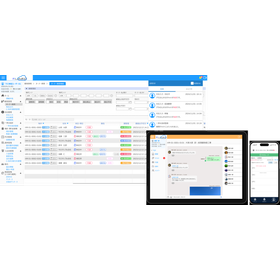"Particle-PLUS" is a plasma and rarefied fluid analysis software that excels in ICP and CCP analysis using particle methods.
"Particle-PLUS" is software suitable for research and development of devices using plasma, compatible with ICP and CCP. - Excels in simulations of low-pressure gases where fluid modeling is challenging - Calculation functions for inductive heating for ICP simulations - Advanced physical model analysis such as CCP and external circuit models - Capable of simultaneously simulating ICP and CCP - Supports 2D and 3D, efficiently analyzing complex models - As a strength of our in-house developed software, customization to fit customer devices is possible ◆ Supports various cases ◆ - Magnetron sputtering - PVD, plasma CVD - Capacitively coupled plasma (CCP) - Dielectric barrier discharge (DBD), etc. ◆ Outputs various calculation results ◆ - Potential distribution - Density distribution/temperature distribution/generation distribution of electrons and ions - Particle flux and energy flux to the walls - Energy spectrum of electrons and ions at the walls - Density distribution/temperature distribution/velocity distribution of neutral gas and more *For more details, please feel free to contact us. sales@wavefront.co.jp
Inquire About This Product
basic information
**Features** - The time scheme uses the implicit method, allowing for stable time evolution calculations over a large time step Δt compared to conventional methods. - The collision reaction model between neutral gas and electrons and ions employs the Monte-Carlo Scattering method, enabling accurate and rapid calculations of complex reaction processes. - The neutral gas module determines the initial neutral gas distribution used in the plasma module mentioned above, allowing for quick evaluation of gas flow using the DSMC method. - The sputter particle module calculates the behavior of atoms sputtered from the target in plasma and neutral gas environments, such as the flux distribution on opposing substrates, which can be evaluated in a short time. - We not only sell software but also conduct commissioned analyses. *For other functions and details, please feel free to contact us at information@wavefront.co.jp.*
Price range
Delivery Time
P4
Applications/Examples of results
【Dual Frequency Capacitive Coupled Plasma】 - Optimization of voltage and other parameters to achieve high-density plasma - Damage to chamber walls - Optimization of power using external circuit models - It is possible to apply voltages to the electrode plates that align with real devices - The waveform of the applied voltage can be simulated smoothly and with relatively realistic voltages - Calculations are relatively stable to avoid applying excessive voltages 【DC Magnetron Sputtering】 - Uniformity of erosion dependent on magnetic field distribution - Adsorption distribution of sputtered materials on the substrate 【Pulsed Voltage Magnetron Sputtering】 - Optimization of the application time of pulsed voltage to efficiently sputter materials 【Ion Implantation】 - The effect of the substrate on the erosion distribution 【Time Evolution of Applied Voltage on Electrode Plates】 - It is possible to observe physical quantities that are difficult to measure experimentally, such as electron density and ion velocity distribution - By investigating electron density and ion velocity distribution, it is possible to examine the uniformity of the film and the damage to the chamber walls - By changing the calculation conditions, optimization of high-density plasma generation at low power is possible
catalog(14)
Download All CatalogsCompany information
Our company develops and sells a "Maintenance Management System" for managing and operating various plants, factories, and other facilities and assets. Currently, this system is undergoing significant evolution into a system that incorporates IoT technologies, such as sensor information and input from tablet devices, as well as AI technologies like machine learning, featuring functions for failure prediction and automatic scheduling. Additionally, as part of the recent trend of digital transformation (DX), there is a growing movement to digitize and automate manufacturing processes and research and development sites in factories to improve operational efficiency. In line with this trend, our company provides a solution aimed at enhancing efficiency in research and development environments, which is the Laboratory Information Management System (LIMS). This software includes features such as workflow management, data tracking, data management, data analysis, and integration of electronic lab notebooks.








![[Case Study] CCP Plasma Simulation Using the Particle-PLUS External Circuit Model](https://image.www.ipros.com/public/catalog/image/01/d15/513467/IPROS49127693160706889091.jpeg?w=120&h=170)
![[Case Study] Particle-PLUS Cylindrical Magnetron Device Plasma Sputtering Simulation](https://image.www.ipros.com/public/catalog/image/01/28d/513469/IPROS57753432477912697050.jpeg?w=120&h=170)
![[Case Study] Particle-PLUS DC Magnetron Sputtering Simulation](https://image.www.ipros.com/public/catalog/image/01/426/513472/IPROS31362668036278405479.jpeg?w=120&h=170)
![[Case Study] Particle-PLUS DC Magnetron Sputtering (3D Calculation) Simulation](https://image.www.ipros.com/public/catalog/image/01/600/513473/IPROS14341653820382667928.jpeg?w=120&h=170)
![[Case Study] Particle-PLUS Counter-Target Sputtering Simulation](https://image.www.ipros.com/public/catalog/image/01/33c/513474/IPROS71008523339880745470.jpeg?w=120&h=170)
![[Case Study] Particle-PLUS Opposing Target Sputtering Simulation](https://image.www.ipros.com/public/catalog/image/01/86c/513475/IPROS47056299894055276861.jpeg?w=120&h=170)
![[Case Study] Particle-PLUS RF Magnetron Sputtering Simulation](https://image.www.ipros.com/public/catalog/image/01/bb3/513673/IPROS35622406148691072631.jpeg?w=120&h=170)


![[For Semiconductors] Analysis Simulation Software *Catalog available](https://image.www.ipros.com/public/product/image/88a/2000379365/IPROS48540037142528242023.png?w=280&h=280)


![Cadmium concentration in rice - Simple measurement kit [for sale]](https://image.www.ipros.com/public/product/image/42a/2001516322/IPROS157372938992547760.png?w=280&h=280)


